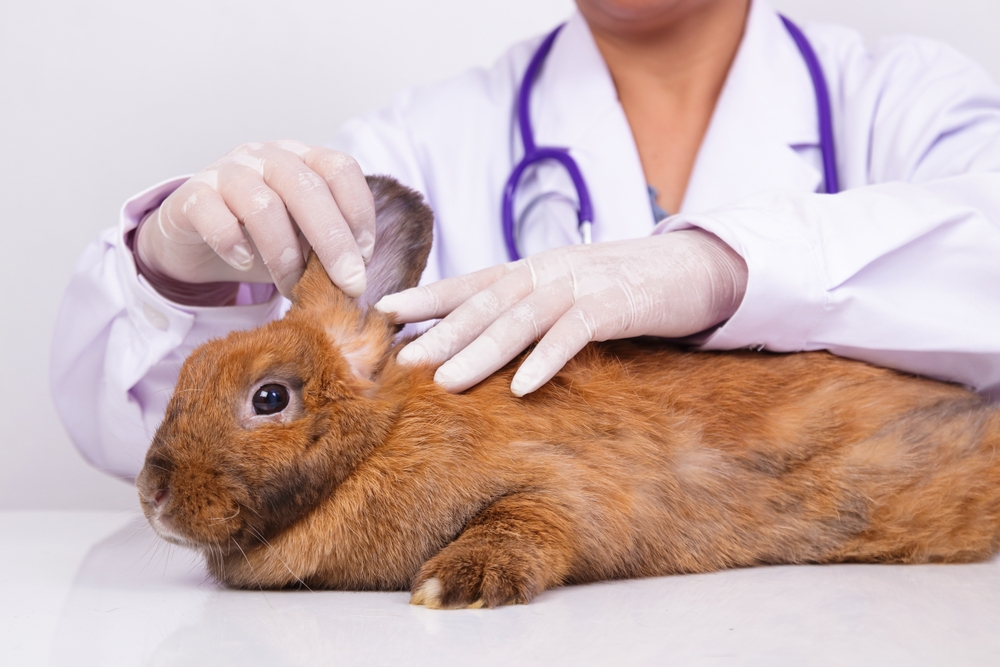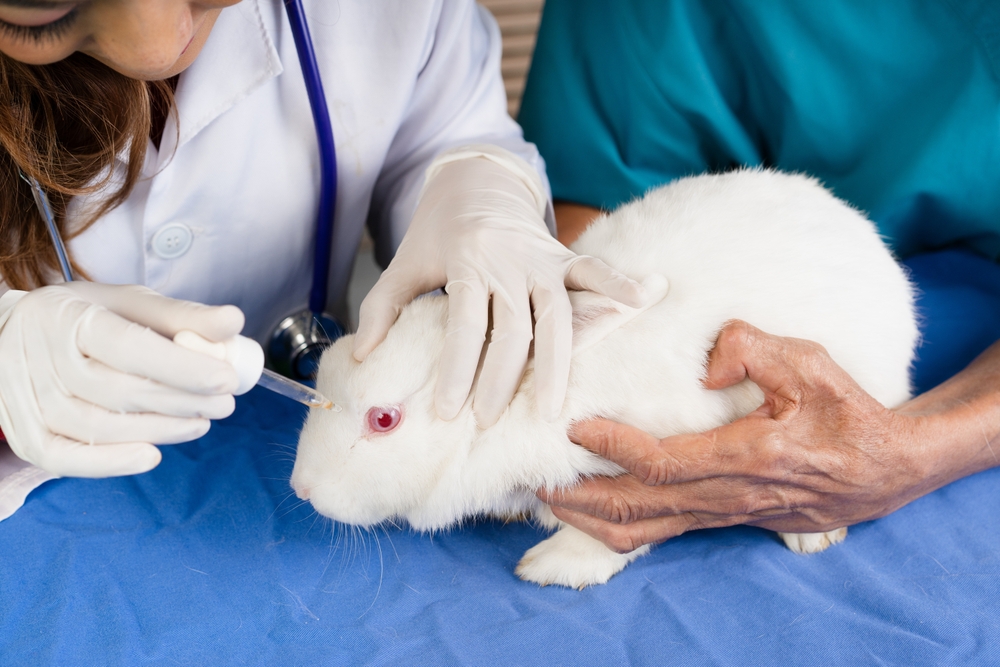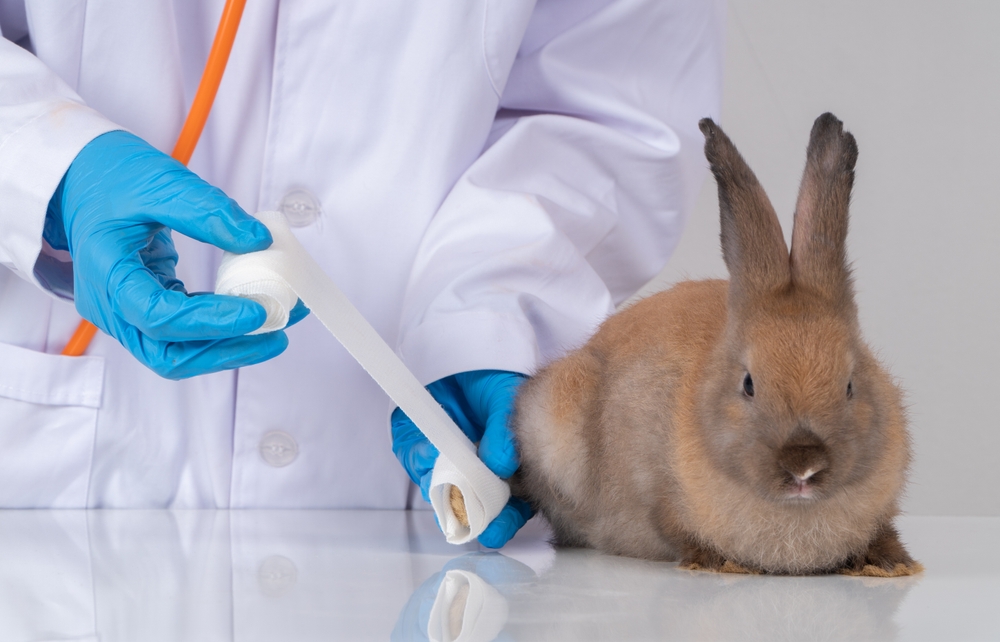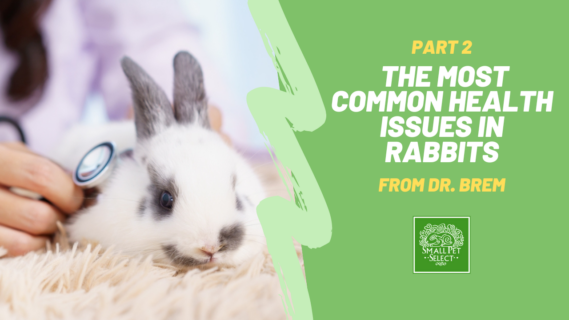Hi, all! Welcome to part 2 of some of the most common health issues in rabbits that I see as a veterinarian. (For part 1, click here.)
Preventing Health Issues In Rabbits
By learning about common health issues in rabbits you will be better equipped to prevent them with proper care.
Ear infections
It’s probably no surprise that rabbits get ear infections!
What causes them:
Several different bacteria, mostly Pasteurella multocida (the same bacterium that causes pasteurellosis, or “snuffles”) but also a few others.
How these health issues in rabbits are diagnosed:
Usually, you will see your rabbit tilting its head. You may also notice its eyes moving side to side or it falling over or walking in a circle. The reason for these signs is that fluid or pus accumulates in the middle or inner ear and affects the rabbit’s balance center, which is within the ear.
Sometimes an ear infection can be accompanied by an upper respiratory infection as well. A veterinarian can often tell if an ear infection is suspected based on his or her exam, but sometimes a CT scan is necessary. This can determine exactly where the infection is and the extent in addition to definitively diagnosing the head tilt as an ear infection.
How they’re treated:
Ear infections need long-term antibiotic treatment with a specific antibiotic or a couple of specific ones. Sometimes the head tilt doesn’t fully get cured. A rabbit of my own, Tucker, got a little better from the antibiotic but lived with a bit of a head tilt for many years after his infection.
If the infection causes severe signs, sometimes surgery is necessary for the best result. This is where a CT scan becomes necessary.
Important: Other things besides ear infections can cause a head tilt in a rabbit, so if you see this sign be sure to take your rabbit to your vet.
Mites
Ear mites can sometimes lead to an ear infection. Both ear mites and fur mites are possible parasites in rabbits.

What causes them:
An infested rabbit and an uninfested rabbit must touch (called “direct contact”) in order to transmit mites from one to the other.
How they’re diagnosed:
Ear mites (Psoroptes cuniculi) irritate ears and cause brown, scab-like crusts to accumulate, so you may notice these crusts, or you may just notice your rabbit shaking its head and scratching its ears a lot.
Your rabbit may have a head tilt and be losing weight. Several species of fur mites are common, and if you notice “dandruff” on your rabbit, especially if it has some loss of fur in the same area, it may have fur mites.
Most rabbit mites do not like to be on anything other than a rabbit, so it’s rare for them to be transferred to humans. (One of the species of fur mites can cause skin irritation, though.)
To diagnose fur mites, a vet will do a skin scrape of an affected area and look under a microscope; he or she can usually diagnose ear mites with an exam only.
How these health issues in rabbits are treated:
A vet will dose the rabbit three times with a topical antiparasitic medication 1-3 weeks apart each. With ear mites, the rabbit’s ears need to be very gently cleaned while under anesthesia and usually both topical and oral antibiotics given. Depending on the species of fur mite, antiparasitic powder may need to be applied to fur and bedding.
Important: Never remove the brown crust of ear mites yourself. This is very painful if the rabbit is not under anesthesia. Issues other than fur mites can cause a dandruff-like condition, so if you see flakiness, take your rabbit to your vet.
Conjunctivitis
Another one of the most common health issues in rabbits is conjunctivitis which is irritation of the inner eyelid tissue.
What causes it:
An object rubbing the eye, dental disease, bacteria, or Encephalitozoon cuniculi (see part 1). “Weepy eye” can accompany conjunctivitis. Weepy eye, or dacryocystitis, is an obstruction of the nasal duct and can be caused by chronic upper respiratory infections or dental disease. Sometimes conjunctivitis is caused by ulceration of the cornea.
How it’s diagnosed:
You may notice redness of the eyes, swelling of the eyelids, discharge around the eyes, or even eyelids partially closed. Rabbits who are affected rub their eyes with their front feet, so you may also notice crusty fur on the front paws.
How it’s treated:
A veterinarian needs to determine the cause of the conjunctivitis and treat it accordingly. Treatment may include an anti-inflammatory eye drop and an antibiotic eye drop. If the rabbit also has weepy eye, your vet may flush the duct that connects the eye to the nose and may have to do that on a regular basis.

Treponematosis
Treponematosis is a rabbit venereal disease with alarming-looking sores.
What causes it:
It is caused by a bacterium (Treponema paraluiscuniculi) and is seen in both males and females. It is transmitted from rabbit to rabbit during breeding or during birth.
How it’s diagnosed:
Small ulcers form in the genital region and sometimes the eyelids and lips, so you may see scabs in those areas. They look similar to warts, but warts are caused by a virus. A vet can diagnose the disease by examining the ulcers and seeing the bacterium with a microscope or by using a special blood test.
How it’s treated:
Treponematosis is treated with a subcutaneous (under the skin) injection of penicillin G every day for five days. All rabbits who are kept together need to be treated even if not displaying any sores, since it is a very infectious disease. The sores usually take two weeks to heal.
Important: Rabbits should never be given oral penicillin or related antibiotics.
Urinary Issues
Some health issues in rabbits come from urinary tract issues, but bladder sludge and urine scald are the two most common. See the blog Urinary System Problems in Small Mammals for more on these two conditions and others.
What causes these health issues in rabbits:
~ Urine scald: It can be the result of obesity, lameness, urinary tract infection, excess skin, or physical malformation.
~ Bladder sludge: Excess calcium gets “stuck” in the bladder because of an inappropriate diet, obesity, not enough exercise, not getting enough water, or issues with the spine.
How it’s diagnosed:
~ Urine scald: You may notice discolored or wet fur, missing fur, and redness or sores on your rabbit’s bottom, legs and feet, and up the abdomen. Your rabbit may make loud grinding sounds with its teeth occasionally, indicating that it is in pain.

~ Bladder sludge: You may see a sandy substance or thick urine in or around your rabbit’s litter box.
How it’s treated:
~ Urine scald: Your vet will clip the affected fur and prescribe a topical medication. He or she will instruct you how to clean the skin and apply the medication. The underlying cause will need to be fixed in addition to the urine scald itself being treated, for example, helping your rabbit lose weight, cleaning the litter box more frequently so that your rabbit doesn’t sit on wet litter, surgery, etc.
~ Bladder sludge: Treatment and prevention both include encouraging more drinking (bowls are better than bottles!) and exercise, feeding an appropriate diet in an appropriate amount, and avoiding higher-calcium foods.
A lot of health issues in rabbits can be prevented with an appropriate diet, a clean environment, and plenty of exercise!





